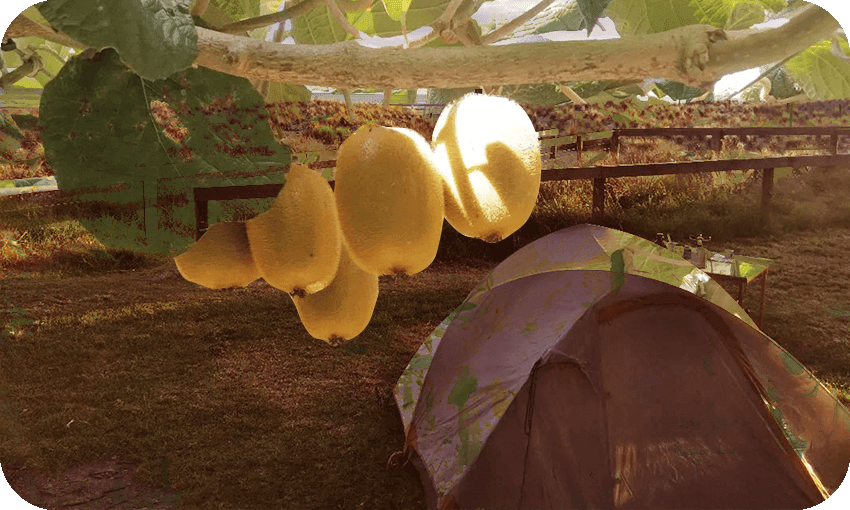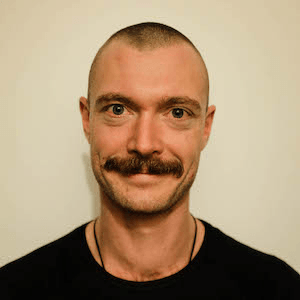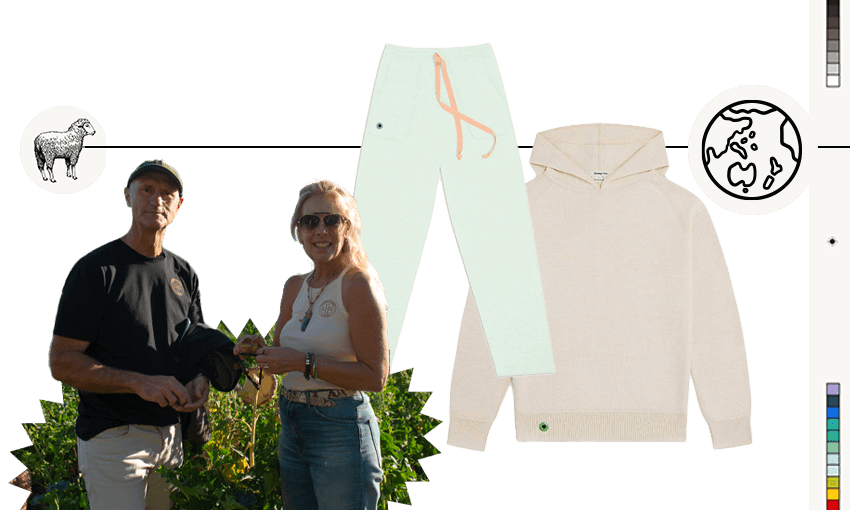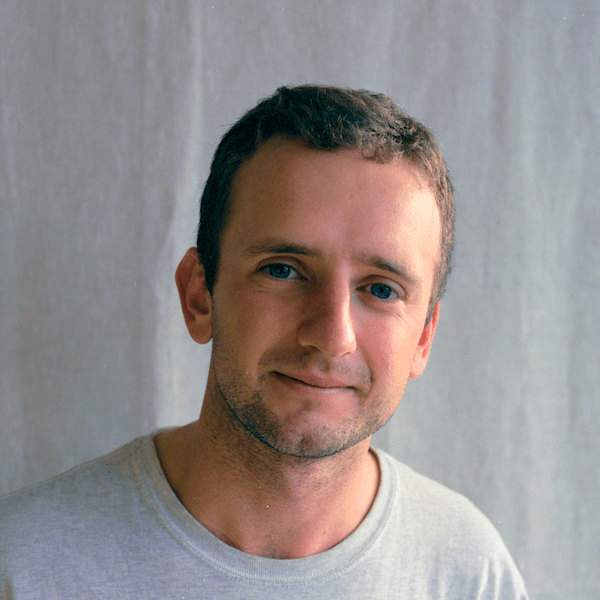The Covid-19 pandemic brought with it ads and news stories trumpeting a dreamy $60 per hour for fruit pickers. Andrew Gunn accepted the call and experienced a different reality.
This story was published in July 2022.
By the seventh hour, you are thinking not so much about the fruit as you are the pure motion of picking the fruit. A kind of harvest geometry. Everybody pacing each other, the grins eventually giving way to grimaces, the flashes of gold teeth, the melodic call and response of “malo toko, malo toko” as we strip through the final few rows. The man to my right is 70 years old, wiry, effortless.
At a certain point, you enter this flow state working the vines, relying on intuition. The eye tracks the fruit ahead, gauging how easily it will snap from the vine based on the size and the way it hangs. The hand learns the exact angle and speed at which to twist the fruit.
The day ends when the fruits are no longer visible. We toss our bags in the back of a trailer, and watch dozens of tonnes of fruit loaded into multiple trucks for grading, then export. The scale is immense, at times overwhelming.
I have fond memories of this time, my first season picking kiwifruit (through levels two and three in 2020). It was egalitarian, the work was reasonably consistent, and the crew’s work ethic was strong. Picking with a Tongan crew, you learn to pick fast. Really fast.
That year, my pay varied between $22 and $31 an hour. The work was reasonably regular in its hours, and I probably averaged out to be working five days a week, weather permitting.
Earlier this year, healing from a range of strange curveballs life had thrown my way, I looked into returning to the orchards. Enticed by a Facebook post promising $60 per hour, I was hooked. $400-$500 a day! There was an article from Stuff days earlier touting this pay rate, so it had to be true. I’d just left a job working in a claustrophobic restaurant, and the idea of vast, open spaces and intensely physical work held a deep appeal.
Picking is supposed to start on March 7 but even boosting it down, I arrive March 9, setting up my tent at nightfall in Pikowai. I get a text upon arrival that work will now begin on the 12th, and that the work is fruit thinning, not picking, which pays $24 per hour. I’m told I’ll be provided with a contract on my first shift.
I wake up and scan the campground. My new neighbours come over to introduce themselves, one leaving a trail of skin flakes behind him from the intense sunburn on his neck. “You down here for the picking as well?” he asks. “Could I grab your boss’s number? Ours is giving us the fucking runaround. We might just do a cruise around today to see where the work is actually at and where the fruit looks big. Maybe we can find a new gang.”
They look well set up, with several fishing rods, chilly bins, a tarp sheltering an improvised kitchen. Many stay in campsites close to the orchards to remain mobile and to save on fuel, with 91 costing $3.36 a litre at the closest station that day.
After several days of counting my pennies on the beach, I turn up for my first day of fruit thinning in Pongakawa. The manager has forgotten to bring contracts with him, and promises he will bring them as soon as possible. “It’s no problem. No problem,” he says. He strokes a handsome clump of the fruit. “Lucky you. You get to pick these big boys.”
It’s rare to be paid an hourly rate when picking. The norm is to be paid a bin rate, each bin carrying around 680 litres (400kg) of fruit. To make good money, every single picker needs to pick extremely fast. The total quantity picked is divided across all pickers in the gang.
But here’s the problem. Often you get to the orchard to find that the fruit is small, or the topography is awkwardly hilly – the fruit hard to reach. Or the contractors through the year have done a bad job of pruning or training the vines, hence a smaller yield, or the fruit is growing awkwardly tucked up in the canopy. Sometimes this is just the result of forces of nature totally beyond your control. Find any of these in your orchard and you can be earning far less than on previous days. Sometimes 40% less, in my experience.
It isn’t until my fourth shift that I’m given a contract, the day before payday. I pore through but am hurried through because my break is ending. I ask for a copy of the contract and am promised one will come. After the shift, I go to sign the timesheet to clock out.
“Don’t worry about that”, says the manager. “I can keep track of that now.”
The gang swells in size once the picking proper begins. We are a motley crew; jaded chefs who lost their jobs once the vaccine mandate hit, patched Black Power members, young sheep and beef farmers chasing seasonal work, drum and bass scratching through the fabric of their cargo pants.
There’s talk of cash-in-hand work further north. The picking is hot and hard work, but rewarding. After a while the fruit doesn’t look like fruit any more, but like huge furry eggs. I imagine dollars falling like fruit from the canopy and paying off my credit card debt.
“Can we take a break, man?”
“You want a break?”
“Yes, you said we weren’t going to break as it was going to rain, but the weather has cleared up.”
“Does anybody else need a break?”
A few hands go up. The disappointment is visible.
“OK. Fifteen-minute break.”
As the break ends, I hear the managers discuss whether they should split us into two gangs – one gang that wants to take breaks, and another “that wants to make money”.
I receive my second payout, and am pretty underwhelmed. I ask for a payslip (the first never arrived) and am told the accountant couldn’t read my handwriting. I don’t get it for eight days. Several of the other pickers are convinced they’ve been underpaid by at least $100. We seem to be making no more than $250 for a full day’s work.
I hear the most senior picker and the manager speaking under their breath. “That can’t be possible. I’m so sure we’ve picked more bins than that.” The manager looks anxious. He traces through the records on his phone. I’m told to constantly check in about the day’s bin count in case any errors are made.
Back at the camp, I take a look at the rain radar to see a huge storm coming in from the northwest. My phone lights up. “See you tomorrow. Same address. 8.30 start.” Prayer hands emoji.
Come 2am the gale starts. My tent begins to prolapse. I spend the rest of the night curling away from the freezing exterior pressing into my spine through the lining. I wake up to find it pissing down. My neighbour’s tarp has collapsed. He’s dragging it through the mud back to his van in a completely sodden hoody. He tries to start the motor. The battery is dead.
We have four days without work while the storm passes, and my pay comes through a day late. The following shift the bins don’t arrive on time and we lose half a day’s work. I resign on the spot, and a day later receive snapshots of my contract. The bin rates haven’t even been written in, only the hourly rate for fruit thinning. It was a handshake deal.
A few weeks later, I start with a new, much larger company with a good reputation. I meet two grinning brothers who had picked cherries through the summer, and said they were making $2,500 gross a week – generally doing 50-hour weeks, coming to $50 an hour.
We put on our bags, sink our weight, and slip back under the vines. A disgruntled muttering rises when we see the size of the fruit. It also becomes apparent there are too many pickers for the scale of the orchard. After three hours of work, as we approach the end of our lines, an RSE gang spins around the corner, cleaning up the final few bays.
“But… those are our fruit.”
The supervisor shrugs as we finish. We had hit our quota.
“I’m sorry guys, that’s all I have for you today.”
I try keeping a closer track of our bin rate. One shift, for instance, we start off picking 1.7 bins per hour, and later in the day (as we approach unhealthy patches of the orchard, and as the newer members of the gang slow down), we’re picking at a rate of one bin per hour. That’s $47.60 vs $28 per hour.
More pickers arrive – backpackers, students on summer break. Our hourly rate continues to drop.
The man picking in the line next to me was once a lawyer in Brazil. He was training to become a judge when he left the country, disillusioned with president Jair Bolsonaro.
“Is anyone here actually making $60 an hour?” he asks the supervisor.
“The RSE workers. You can only really get to that point if you’ve been doing it for a few years. Look at them go.”
Our heads all turn to watch the Vanuatu gang several lines over. Their hands are a blur, like sped-up camera footage. Working the harvest geometry.
Tensions rise on the final day of the gold season. I plead with someone to stop rain-picking (dropping the fruit straight from the canopy into the bag).
“You are bruising the fruit, man! These fruit are really soft!”
I struggle to find the right tact.
“It’s a bummer going to buy fruit in the supermarket to find that a whole lot of the fruit are bruised, right?”
“I actually don’t give a fuck, man.”
“If we fail the audit they aren’t going to choose our gang! We all need the work!”
Everyone starts defending him.
“Stop picking on him. Look around you, we are all picking like that!”
I look behind me. They are. I’m about to describe a port in Zhanjiang receiving a ship of kiwifruit, doing a quality control check, only then to literally turn the boat around and send it all the way back to Mt Maunganui, burning five million litres of marine fuel along the way, to be assessed by a food tech grad who comes to the conclusion that people have been rain-picking.
My fellow picker has a point. The issue is systemic. There’s no incentive to care about anything other than speed.
“If they want us to care about looking after the fruit, they should really pay us more. A higher base rate, you know. This is way too unpredictable.”
I ask if I can join another, more experienced gang. I am told it’s not possible. For the next five days there’s no work as we transition from the gold season into green. I quit.
I leave the Bay of Plenty with little more cash than I arrived with. Although the claims of making $60 an hour are not untrue, they are a gross misrepresentation of the norm. A sense of chaos seems to underlie the picking sector. Standards of work vary dramatically from company to company. MBIE found less than half of the kiwifruit-picking contractors audited in a 2017 survey met basic New Zealand employment law standards.
Cash-hungry seasonal workers descending on the Bay of Plenty feels like a 21st-century gold rush; swagmen camping near the prize, some striking lucky, others not. Itinerant workers whose income and job security is dictated by the soil, by the sun, by the wind, by rain and hail, and by the contractors before them.
“Picking kiwifruit isn’t all that bad though,” said one supervisor. “There’s far worse things to be picking.”
“What’s the worst?”
“Watermelons, bro. It’s gotta be watermelons.”
That does check out. I’m glad I wasn’t picking watermelons.





